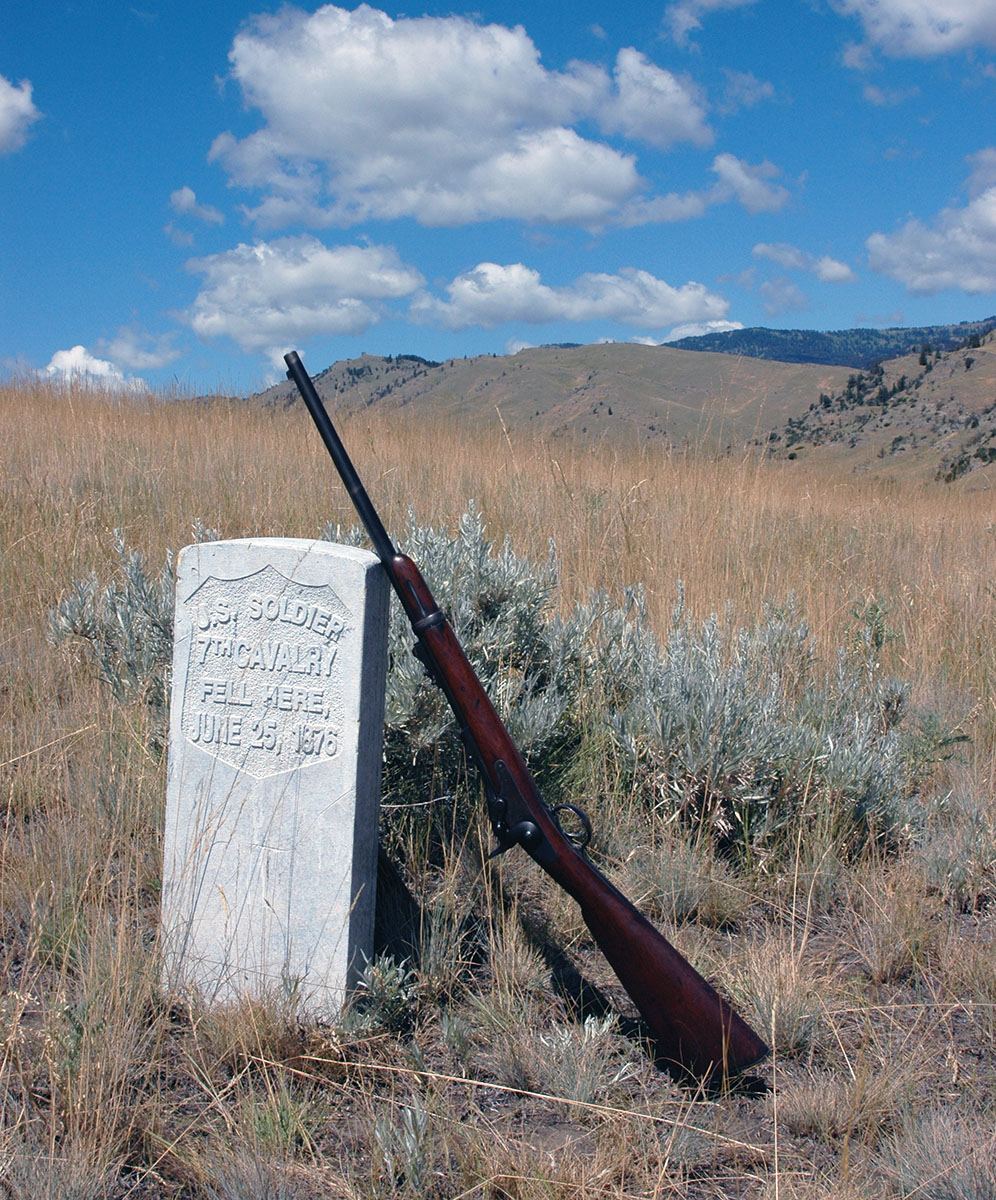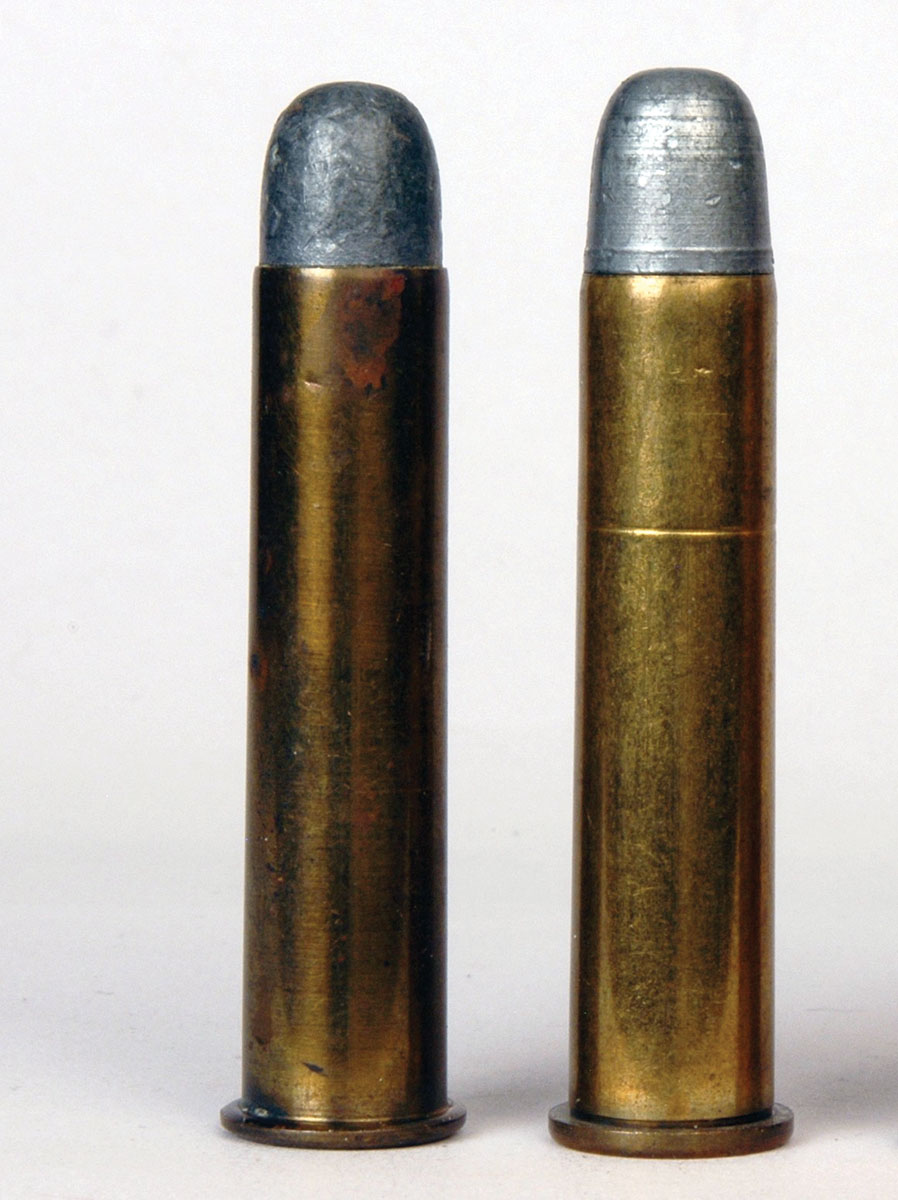Down Range
Springfield Model 1873 Carbine
column By: Mike Venturino, Photos by Yvonne Venturino | July, 24


First, let’s take a look at M1873 carbine details. The barrel length was 22 inches while the overall length was 41.3 inches and the nominal weight was 6.87 pounds. Its basic mode of operation was as follows: to load, the hammer was raised to its half-cock position. Then the breechblock operating tab could be flipped upwards, exposing the chamber. After a cartridge was inserted and breechblock shut, the hammer could then be fully cocked. The carbine could be fired or if necessary, it could be carried loaded but the latter required that the hammer lowered to its safety position, which blocked the breechblock from opening and also kept the hammer clear of the firing pin. Sights consisted of an open rear with notched blade and a “barley corn” front dovetailed into a barrel stud. Sight graduations were to an impractical distance of 1,200 yards.
When M1873 rifles and carbines were introduced, they brought with them a brand new cartridge first named simply 45 Gov’t. It was loaded with hollowbase, 405 grain, swaged roundnose, .458-inch bullets of one part tin to 12 parts lead. These were seated over 70 grains of “musket grade” black powder in a copper case of 2.10 inches. Very quickly, the recoil of the 70-grain powder charge was deemed excessive in carbines, so a special load with only 55 grains of powder was introduced. The excess space caused by only 55 grains of powder was filled with “pasteboard” wads. Somewhat later, cardboard tubes were inserted in cases to fill the excess case volume. (In archaeology done at the Little Bighorn battle sites, some fired 45-55 cases were dug up with the remains of those tubes still inside.) Velocity from M1873 carbines’ 22-inch barrels was nominally rated at 1,150 feet per second (fps).
As the years passed, there were inevitable revisions of M1873 rifles and carbines. However, as best as my research has determined, they were only stamped Model 1873 and Model 1884. The barrel bore diameter was always .450 inch with three groove rifling, .005-inch deep and a twist rate of 1:22. Production of M1873 carbines ceased in 1889, with a total of 59,909 made.
(Author’s Note: The information given in the above three paragraphs was gleaned from the book by M.D. “Bud” Waite and D.B. Ernst. Although it is out of print, copies can often be found on eBay or Amazon. The book is a treasure trove of detailed information about all Springfield trapdoors.)
Now, let’s return to the Battle of the Little Bighorn. As said earlier, the charge that M1873 carbines often failed to extract fired cases contributed greatly to the 7th Cavalry’s defeat. It is true that archaeologists discovered cartridge cases with nicks on their rims that would have been made by knives prying out stuck rounds. Historians feel that the number of such cases found was not enough to cause the 7th Cavalry’s disaster. Also worthy of note is that M Company’s First Sergeant, John Ryan, related in later years that his unit’s leader, Captain French, carried a “Long Tom” 50 Springfield infantry rifle into the battle. In the hilltop siege, its long cleaning rod was used to free M Company’s carbines of stuck cases.
The actual fault causing the M1873 carbines’ failure to extract fired cases was due to copper cartridge cases. The day of the fight was extremely hot and black powder leaves considerable fouling in chambers and barrels, so soft copper cases could not easily be freed from dirty chambers. Within a year after the big fight, M1873 carbine buttstocks had holes drilled for storing jointed cleaning rods.
As of this writing, I’ve owned and handloaded for a Model 1873 carbine for 49 years. While no tack driver, it could have been an effective arm for fighting at some distance. For example, as a favor for a film crew and done within sight of the Little Bighorn Battlefield National Monument, I was able to hit an 18x24-inch steel torso target placed at 325 yards (lasered). Not every shot was on target but when the barrel wasn’t too fouled there were more hits than misses.
The problem on June 25, 1876, was that Indian warriors didn’t hold still to be shot at. Mostly on foot, they popped up and down while moving often. The M1873 carbine’s accuracy was nigh on useless. Conversely, troopers on skirmish lines stayed still and even worse, every fourth man was holding four horses. That gave warriors better targets at which to pump lots of rounds from their Winchester and Henry 44s.
My favorite M1873 45-55 carbine load uses 395-grain bullets from Lyman mould No. 457124. A 1:20 tin-to lead alloy causes the increase over Lyman’s catalog weight of 385 grains. In profile, it is very similar to the original government bullets. The sizing diameter is .459 inch and the lube is either DGL or SPG. Under the 395-grain bullets, 55 grains of Swiss 1½ Fg black powder is dropped. Between powder and bullet, a .060-inch thick vegetable wad goes in. With modern (thicker) brass, that charge weight doesn’t leave any space when the bullet is seated. On various days I’ve chronographed that load at 1,165 to 1,199 fps.
As far as I can determine, after the Little Bighorn battle, there were no other charges of Model 1873 carbines suffering stuck cases.


